The Archean Terranes of Minnesota (cont.)
4.3 Morton Block: Lithography (continued):
More microphotographs
1-Hand sample
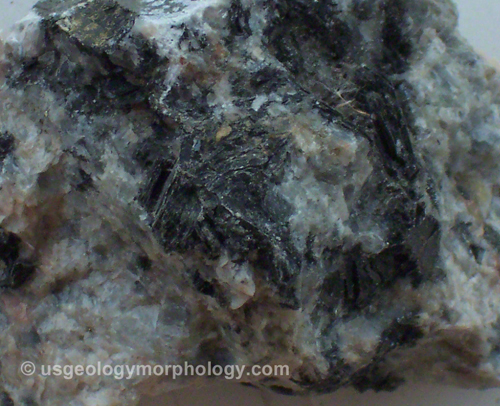
Figure 4.3-5. Hand sample of Morton gneiss
Sample showing the dark-gray amphibolite and the off-white tonalite gneiss (same location as fig. 4.3-1). Width of view: 4 cm.
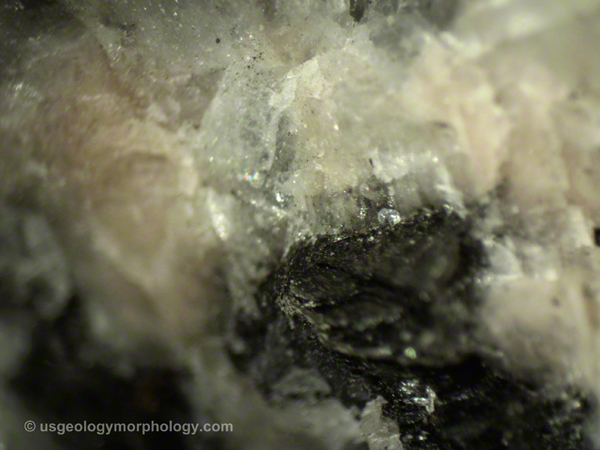
Click on image for full-size zoomable image
Figure 4.3-6. Close-up of Morton gneiss (sample of fig. 4.3-5).
Dark-gray mineral is amphibole (hornblende). Plagioclase crystals are off-white. Width of view: 7 mm.
2-Undulose extinction in quartz
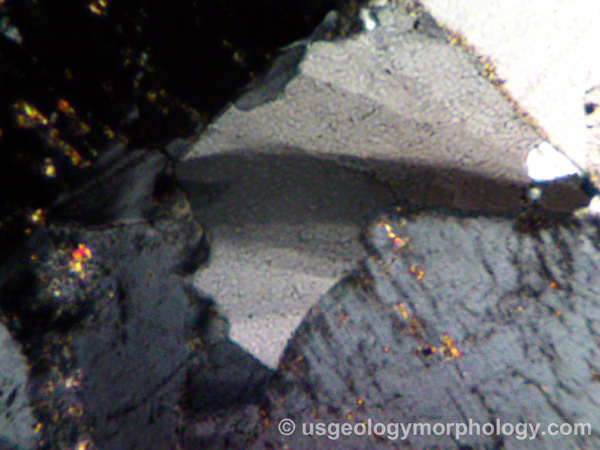
Figure 4.3-7. Nice example of undulose extinction of quartz
The undulose extinction in quartz, here in Morton tonalite gneiss, is due to deformation. Crossed nichols. Field of view: 1.1 mm. More below.
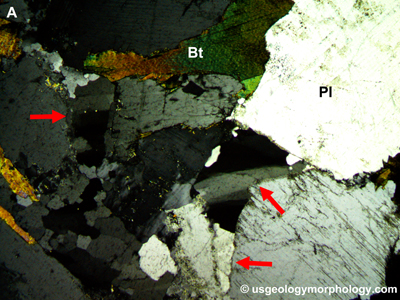
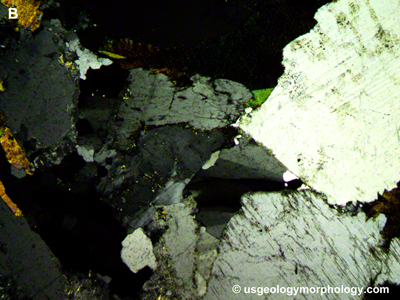
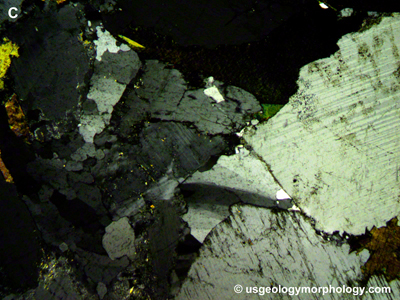
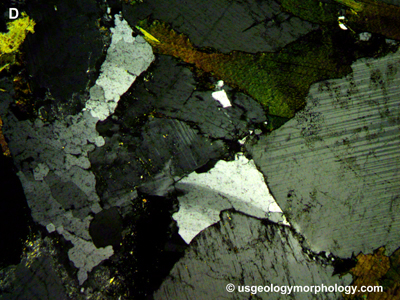
Click on each individual image for full-size zoomable image
Figure 4.3-8. Undulose extinction of quartz grains in Morton tonalite gneiss.
Field of view: 2.3 mm. The microscope stage has been rotated 10 degrees between each photo (clockwise from A to D). Usually, a grain of quartz experiences complete extinction every 90 degrees. Undulose extinction (also called undulatory extinction), i.e. the extinction of different parts of the same grain at different angles happens when the grains have been subjected to deformation. Red arrows in image A point to the quartz crystals displaying undulose extinction. In images B and C, the biotite grain labeled in image A shows extinction almost parallel to cleavage. In image D, the plagioclase grain labeled in image A at right is 10 degrees from extinction, also nearly parallel to cleavage (it is oligoclase: see part 4, "use of the Becke line", below); incomplete twinning is often due to deformation. Crossed nichols. Bt-biotite; Pl-plagioclase feldspar.
3-Another thin section of Morton tonalite gneiss


Figure 4.3-9. Morton tonalite gneiss thin section.
Left: plane polarized light. Right: crossed polarizers. Field of view: 2.3 mm. This area shows big quartz crystals and some plagioclase feldspar. In plane-polarized view, both minerals look similar with a neutral color. In crossed polarized light, different orientations give the quartz crystals various colors from white to black (extinction). Notice the almost perfectly-shaped subhedral quartz crystal (appearing white) at left. Plagioclase feldspar shows irregular twinning due to strain. The quartz crystal in the center has two biotite inclusions. Bt-biotite; Pl-plagioclase feldspar; Qtz-quartz.
4-Use of the Becke Line
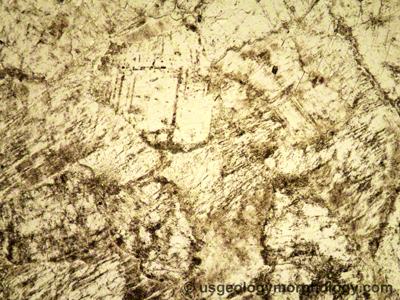
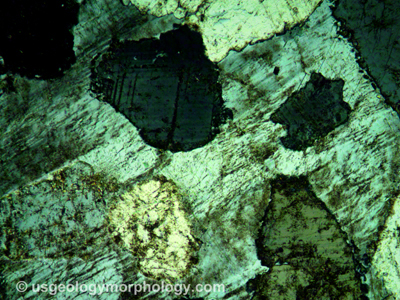
Figure 4.3-10. Morton tonalite gneiss thin section.
Left: plane polarized light. Right: crossed polarizers. Field of view: 2.3 mm. This area of Morton tonalite gneiss shows only quartz (big round or ovoid crystals) and plagioclase feldspar (weakly twinned).
Here is another sample of Morton tonalite gneiss with only quartz and plagioclase feldspar. Plagioclase [general formula: (Na,Ca)(Al,Si)O8] is a solid solution of albite (Ab: NaAlSi3O8) and anorthite (An: CaAl2Si2O8) in variable proportions: from 0% to 100 % anorthite (and vice-versa of course). The Becke Line technique will enable to determine the nature of plagioclase in this example. One has to use plane-polarized light, a magnification of at least 40x (the case here) and to partly close the aperture diaphragm (hence the muted colors). If the microscope is out of focus, which explains the blurriness of fig. 4.3-11, a white line, the Becke Line, appears near the boundaries of the crystals and moves as the focus, i.e. the distance between the stage and the objective, is changed. If that distance is decreased (the case here), the Becke Line moves into the crystal with the lesser refractive index. On the contrary, if that distance is increased, the Becke Line moves into the crystal with the higher refractive index. On fig. 4.3-11, the Becke Line is always outside the quartz crystals, which proves that the plagioclase has a lower refractive index (RI) than quartz. The RI of quartz is 1.5442 or 1.5533, depending on the orientation of the crystals in the thin section. The RI of plagioclase varies from 1.529 (pure Ab) to 1.583 (pure An). The plagioclase shown here has a RI < 1.544; it can be only oligoclase (10-30% An) or albite (0-10% An). The Becke Line technique (also called the Becke Line test) can only determine which RI is greater. For a finer analysis of plagioclase one has to measure the extinction angles relative to cleavage of the crystals whose axis are either parallel or normal to the section. Here these angles (not shown) are within the values for oligoclase, which confirms the findings of Lund (1956).
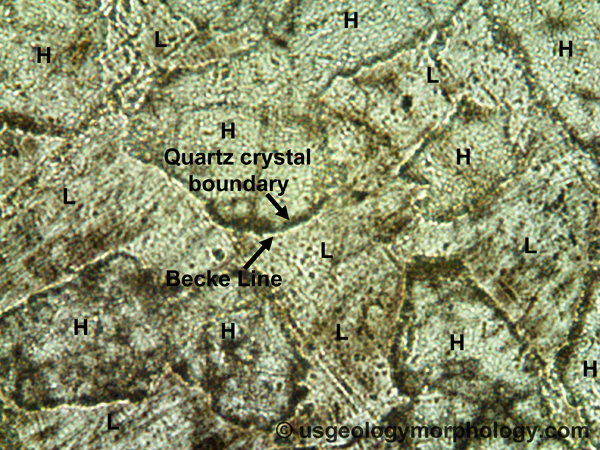
Figure 4.3-11. Use of the Becke Line method to determine the composition of plagioclase.
Use of the Becke Line method to determine the composition of plagioclase feldspar in the Morton tonalite gneiss. The distance between the stage and the objective has been shortened. H-higher refractive index; L-lower refractive index. The quartz crystal boundary appears as a dark line, the Becke Line as a white line. Plane-polarized light. Field of view: 2.3 mm.
(To be continued)
